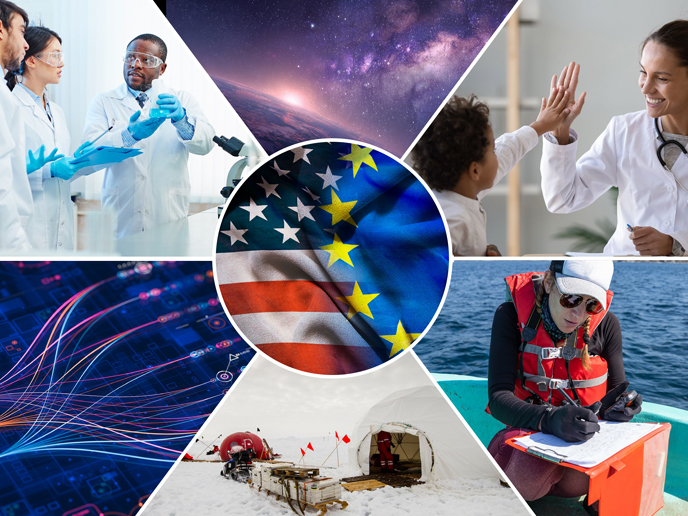How EU-U.S. research collaboration is delivering far-reaching benefits
The European Union and United States partnership is one the world’s most important bilateral relationships, indispensable for global security and prosperity. Common values such as openness, transparency, and research integrity and security are reflected in the shared approach to science, technology and innovation. The EU-U.S. joint statement(opens in new window) on research and innovation cooperation of January 2025 forms a basis for the continued commitment of both sides to this partnership. Furthermore, the United States has one of the highest levels of participation in the European Union research and innovation program – Horizon Europe(opens in new window) – of all non-EU countries, with numerous opportunities for American researchers. U.S. involvement in EU-funded projects brings together complementary expertise and creates a multiplier effect in terms of positive impacts. For example, Marie Skłodowska-Curie Actions(opens in new window) fellowships offer postdoctoral researchers from the U.S. the chance to spend up to two years at a European institution (and vice versa). American researchers can also apply for prestigious European Research Council(opens in new window) grants to carry out cutting-edge, pioneering research that expands the frontiers of knowledge. Collaborative research projects under the Horizon Europe program bring European and American researchers together to tackle a range of global challenges. All these opportunities are available for U.S. researchers to develop their field of expertise, plug into global scientific networks, and advance their careers.
Benefits on both sides of the Atlantic
This Results Pack highlights the opportunities and benefits for U.S. researchers in advancing excellent science by cooperating in EU-funded projects. This international cooperation greatly expands researchers’ perspectives, advances scientific knowledge and leads to useful real-world applications. Global health strategies, for example, benefit from drawing expertise from all corners of the Earth. Integrating perspectives on public health efforts and consumer behavior from both sides of the Atlantic can help to improve global approaches to nutrition. The involvement of U.S. partners also enriches research into shared geographical spaces such as the Arctic, and the Atlantic Ocean. For example, collaborative work can strengthen monitoring capabilities, leading to new understandings and discoveries. Sharing knowledge and data, and opening cutting-edge research facilities to experts from elsewhere, enables scientists to more efficiently arrive at solutions that can have global impact. Expertise in AI and access to supercomputer infrastructure have also been harnessed by researchers looking to speed up data analysis and clinical workflows. The application of AI across a range of fields, from healthcare through to satellite observation, is opening new commercial opportunities for innovative start-ups. Our transatlantic collaborative research benefits citizens on both sides of the Atlantic. When it comes to healthcare, the ERDERA project is bringing together an international consortium to deliver a sustainable, long-term global strategy that addresses rare diseases. Doctoral students from Europe were able to spend two years developing new clinical tools to diagnose breast cancer in the United States thanks to the BosomShield project. SMART PROTEIN, meanwhile, integrates perspectives on consumer behavior from both sides of the Atlantic, critical to building a truly sustainable global protein industry and creating new market opportunities. GREENART combines European advances in green materials and heritage conservation with U.S. analytical expertise and conservation skills to pioneer more effective art restoration techniques. CASTLE has brought together a transatlantic team to harness the power of electron spin, opening a new world of possibilities for quantum devices. Similarly, the transatlantic Qurope project is pushing forward hybrid quantum repeaters to ensure the security and efficiency of future quantum communications. GO-VIKING brings together American and European researchers to boost the safety and reliability of nuclear reactors. Relating to the environment, iAtlantic expands significant EU-U.S. collaboration for monitoring the depths of the Atlantic Ocean. North American partners have also been instrumental in strengthening Arctic monitoring capabilities through the INTERACT project. SWIM combines AI-based environmental monitoring tools from the EU and the U.S. to improve water management for farmers and other critical end users. Other projects demonstrate that when it comes to collaboration, the sky is not necessarily the limit. The FARBES project brought researchers from the EU and U.S. together to help protect satellites from the potentially devastating effects of solar storms. Meanwhile, GAIA Unlimited combined competences to help astronomers make the most out of satellite data, providing an unlimited view of the Milky Way. PiCOGAMBAS delved even deeper, bringing transatlantic expertise together to probe some of the deepest cosmological mysteries, such as the evolution of the universe.



